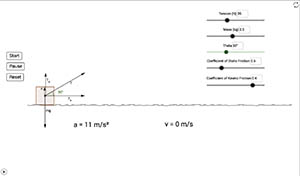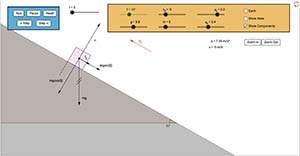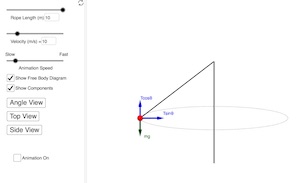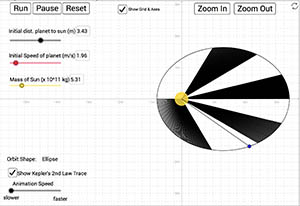
|
Friction: Pulling a Box on a Horizontal Surface
This is a simulation of a box being pulled along a horizontal surface by a rope. Students can use the simulation to explore the effects of static and kinetic friction and their relationship to the normal force of the surface.
|

| Static and Kinetic Friction on an Inclined Plane
This is a simulation of a box being pulled along a horizontal surface by a rope. Students can use the simulation to explore the effects of static and kinetic friction and their relationship to the normal force of the surface.
|

| Atwood's Machine / Atwood's Incline
This is a simulation of two objects attached to each other with a massless string. The string passes over a massless, frictionless pulley. Use the "Run" button to start the simulation, the "Pause" button to pause it, and the "Reset" button to reset the time back to zero. Use the sliders to adjust the masses of the two objects, the angle of the incline, and the coefficient of friction between mass m2 and the incline (in the simulation it is assumed that the static and kinetic friction coefficients have the same value). Use the checkboxes to show or hide the numerical values and the free body diagrams for the two objects.
|

| The Pendulum
This is a simulation of a simple pendulum. Adjust the length, initial angle, and gravitational acceleration. Examine the forces, acceleration, velocity and energy of the pendulum.
|

| The Conical Pendulum
This is a simulation of a conical pendulum. A conical pendulum consists of an object attached to a string and moving in a horizontal circle. The string length in the simulation is fixed, adjust the radius, animation speed, and view angle with the sliders.
|

| Conical Pendulum: 3D
This is a 3D simulation of a conical pendulum. A conical pendulum consists of an object attached to a string and moving in a horizontal circle. Adjust the string length, velocity, animation speed, and view angle.
|

| Elliptical Orbits & Kepler's 2nd Law
This is a simulation of a planet orbiting a sun. Initial conditions can be adjusted.
Use the sliders to adjust the initial speed of the planet, the initial distance from the center of the planet to the center of the sun, and the mass of the sun. Hit run to see the orbit animate. The orbit will be with elliptical, circular, parabolic, or hyperbolic, depending on the initial conditions. Show the Kepler's 2nd Law of planetary motion trace to see the elliptical orbit broken into eight wedges of equal area, each swept out in equal times.
|